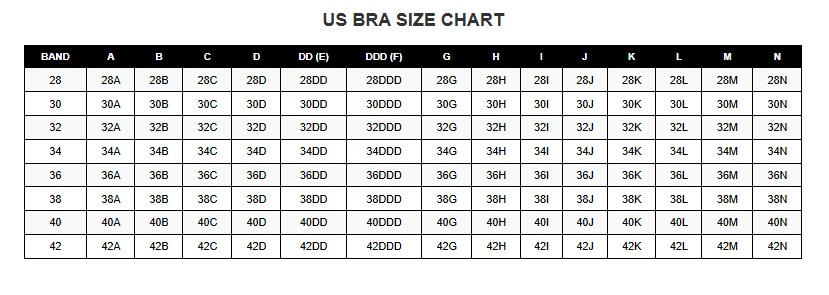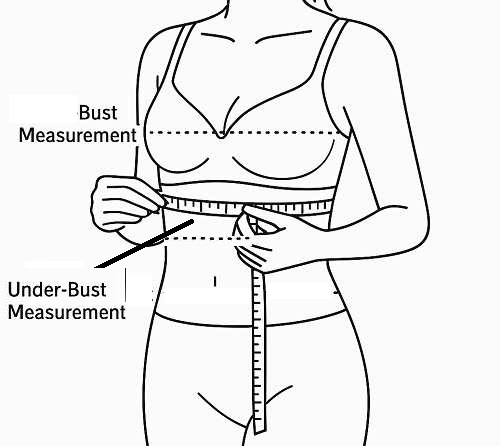Bra sizing can seem like a simple concept at first glance, but once you dive deeper, you’ll discover that it is a complex and sometimes confusing system. The number of bra sizes isn’t fixed — it varies across brands, countries, and body types. Understanding how to find the right bra size for yourself can make a world of difference in terms of comfort, support, and confidence.
First, let’s see a US bra size chart for better understanding. After seeing this chat, you can think it’s critical, but after completing this article, you will be clear.

The Anatomy of a Bra Size
A bra size consists of two main components: band size (represented by numbers) and cup size (represented by letters). These two elements come together to define your overall bra size. Let’s break down these components and the process of finding the right size:

1. Band Size (The Number)
The band size refers to the measurement around your rib cage, just below your bust. It tells you how tight or loose the band of your bra should be. The band is one of the most important parts of the bra as it provides most of the support.
- How to Measure the Band Size:
- Take a soft measuring tape and wrap it around your rib cage, right under your bust.
- Make sure the tape is snug, but not too tight.
- Round the measurement to the nearest even number (e.g., 32, 34, 36, etc.).
- If you measure a number like 33, you should round up to 34, which is the nearest even number.
- The band should be comfortably snug on your body. When you wear a bra, it should sit comfortably on the loosest hook, and as the band stretches out with time, you can adjust it to tighter hooks for a better fit.
2. Cup Size (The Letter)
The cup size is determined by the difference between your bust measurement and your band measurement. It represents the volume of your bust in relation to the band size. The larger the difference between your band size and bust measurement, the larger your cup size will be.
- How to Measure the Cup Size:
- Take a soft measuring tape and wrap it around the fullest part of your bust, ensuring the tape is parallel to the ground.
- Ensure the tape isn’t tight — it should be comfortably around your bust.
- Subtract your band size from your bust measurement. The difference will give you the cup size:
- 1-inch difference = A cup
- 2-inch difference = B cup
- 3-inch difference = C cup, and so on.
- For example, if your bust measurement is 36 inches and your band measurement is 34 inches, the difference is 2 inches, which means your cup size is B.
Sister Sizes Also Matter
One key concept in bra sizing is sister sizing. Sister sizes refer to sizes that have the same cup volume but different band sizes. If your size is uncomfortable or hard to find, it’s worth checking sister sizes to see if a different band size with a larger or smaller cup works better. For example:
- If you wear a 34B and find the band too tight, you could try a 36A (which has the same cup size but a larger band).
- Conversely, if you’re wearing a 38C but find the band too loose, you might try a 36D (which has the same cup volume but a tighter band).
The Complexity of Bra Sizes
When it comes to determining the number of available bra sizes, the system seems infinite. Here’s why:
- Variety of Measurements: Different women have different body types, and bra sizes are a reflection of this variety. For instance, some women might have a smaller band size but larger cup size, and others might have a larger band size with a smaller cup size.
- European and US Sizing Differences: Bra sizing conventions can differ depending on where you are in the world. For instance, European sizing and US sizing don’t match up directly.
- US Sizing: Typically, American bra sizes go from A to N, with increments like A, B, C, D, DD (or E), DDD (or F), G, H, and so on.
- European Sizing: Uses a similar letter system but may not have double letters like DD or DDD. For instance, a 32DD in the US would be a 70E in European sizing.
- Australian Sizing: Australia and New Zealand use a unique system where the band size starts at 8 (which equals 30 inches in the US system) and increases by 2s.
Additionally, different brands may use slightly different size ranges or measurement systems, making it even more complicated. Some manufacturers might offer sizes from 30 to 56 for band sizes, while others may focus on a narrower range.
Standard Sizing vs. Custom Sizing
In addition to traditional sizing, some lingerie brands may offer standard sizing, which uses terms like Small, Medium, Large, or Extra Large. This system is typically used for more relaxed, non-structured garments such as camisoles, bralettes, and certain types of bodysuits. Standard sizing doesn’t focus on the cup size but rather the overall measurements for a looser or more fitted style.
The Largest Bra Size
The largest bra size ever recorded was for a woman in Georgia who wore a 102 ZZZ bra. However, most bras sold commercially in the United States go up to a N cup, with band sizes ranging from 30 to 58 inches. While this is on the extreme end, it demonstrates that bra sizing is highly individual.
Why is Sizing Important?
Wearing the correct bra size is essential for several reasons:
- Comfort: A bra that fits correctly supports your bust without causing discomfort. If your bra is too tight, it can pinch and cause pain. If it’s too loose, it won’t provide the necessary support.
- Health: Ill-fitting bras can lead to shoulder and back pain, poor posture, and even issues like chafing or irritation. The right fit keeps your body aligned and minimizes strain.
- Appearance: The correct bra size can enhance your natural shape, make clothes fit better, and provide a smooth silhouette under your garments.
- Confidence: When you’re comfortable in your bra, you’re more likely to feel confident, as a good fit can make a significant difference in how you feel throughout the day.
How to Find the Right Bra Size
The best way to determine your bra size is by getting a professional fitting, but you can also measure yourself at home. Follow these steps for a more accurate fit:
- Measure your band size: Wrap a soft tape measure around your rib cage, just below your bust, and round to the nearest even number.
- Measure your bust size: Measure around the fullest part of your bust while keeping the tape snug but not tight.
- Subtract the band measurement from the bust measurement to find your cup size.
- Try on bras: Sizes vary from brand to brand, so always try on a few bras in your size range to find the best fit.
Conclusion
There is no simple answer to the question, “How many bra sizes are there?” Bra sizes are as diverse and unique as the women who wear them. The number of sizes available is practically infinite due to variations in body shapes, sizing systems across regions, and different brand definitions. The key to finding the right bra is to measure yourself properly, be aware of the nuances of sizing systems, and try different styles and brands to discover what works best for your body.
Remember, the most important thing is comfort. A well-fitting bra should provide the necessary support, enhance your natural shape, and help you feel confident and comfortable all day long.
You can read Other article for better understanding about All over apparel